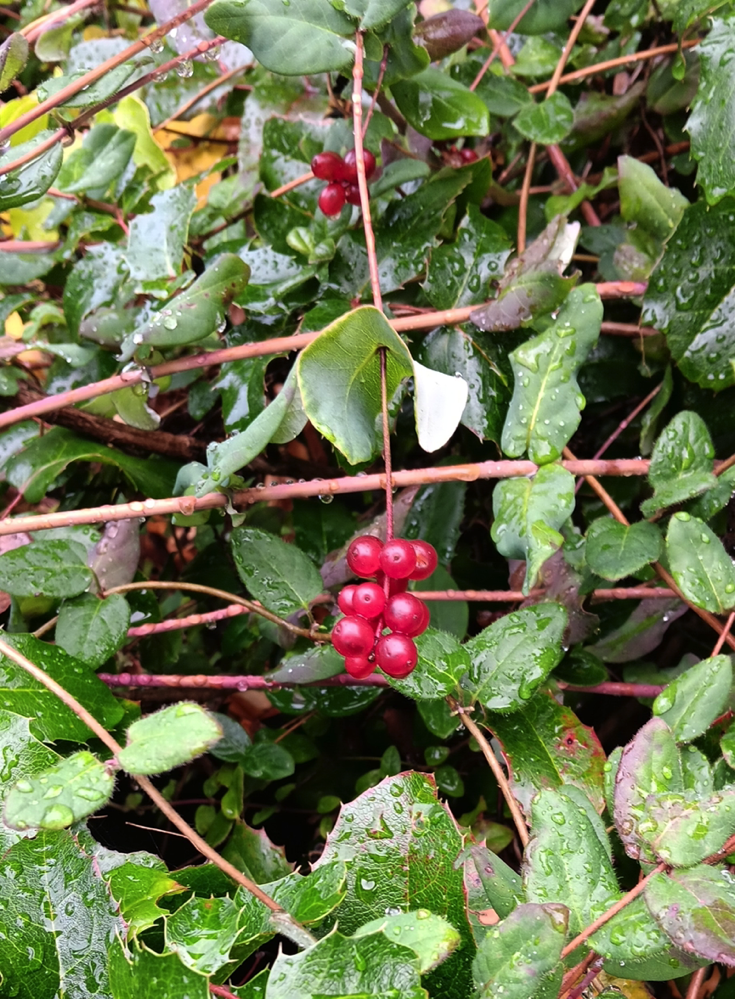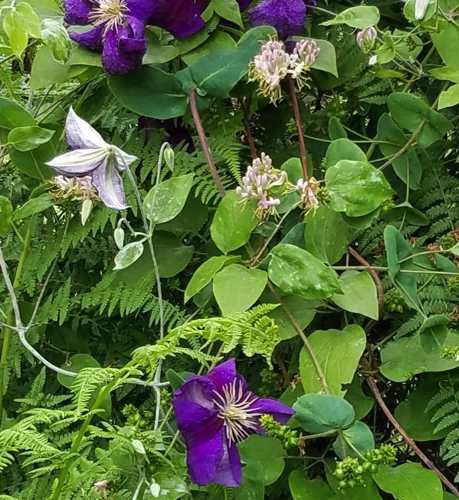
by Marilee Henry


In my garden this month hairy honeysuckle is showing off its ruby-red clusters of ripe berries, gleaming like jewels and inviting numerous birds such as juncos, robins, finches, and flickers to snag them for a juicy meal! Last June, growing in a verdant mass intertwined with clematis over my backyard fence, the flowers attracted hummingbirds, bumblebees, and other beneficial insects while the lush foliage provided safe shelter and nesting sites for small birds. It is an important larval host for at least several dozen species of moths and butterflies, including the garden tiger moth (Artica caja), the white-lined sphinx moth (Hyles lineata), and the geranium plume moth (Amblyptilia pica), all of which are critical food sources for hungry baby birds. This beautiful native vine is a star performer in the landscape while benefiting many native pollinators and wildlife.
Indigenous peoples used the hollow stems of hairy honeysuckle for stems on their pipes. The ashes from burnt stems were also made into a black pigment applied in tattooing. The berries, however, were not a food source as they are mildly toxic to humans.
In natural settings, hairy honeysuckle is found at low elevations west of the Cascade crest, most abundantly in the Puget Sound lowlands in Washington State, and ranges mostly in coastal regions from British Columbia to just north of Los Angeles, with pockets in the Sierra foothills. Found in forest understories and edges to open woodlands, thickets, balds, or along streambanks, this native is very adaptable to various moisture regimes from those that are moist most of the year to those that are drier in summer with minimal supplemental water.
Lonicera hispidula (hairy honeysuckle) can be identified by its "viny" form, its pinkish-white (sometimes yellowish to white) hairy-throated tubular flower clusters with blooms that are 0.5 inch to 0.75 inches in length, and its bluish-green leaves that range in length from 0.75 to 2.8 inches which may also be hairy. Lonicera ciliosa (orange honeysuckle), our other western Washington honeysuckle vine species, has longer bright reddish-orange corolla tubes of up to 1.5 inch in length and larger, lighter green leaves of up to 4 inches in length. The berries of hairy honeysuckle are a bright, almost translucent red color, and tend to hang away from the terminal leaf pair on a visible stem, while orange honeysuckle berries are more orange, not translucent, and cluster closer to or cradle in the terminal leaves. Both vines have opposite leaves along their stem lengths, the terminal one or two pairs of leaves being fused together at their bases, and blooms having 5 prominent yellow stamens that extend beyond their corollas. Three other native plants in the honeysuckle family that occur west of the Cascade crest are shrubs, not easily confused with the native viny honeysuckles.
One might think that honeysuckle nectar can only be accessed by pollinators such as long-beaked hummingbirds or long-tongued bumblebees due to their lengthy corolla tubes. But do not underestimate Mother Nature! Many insects without long appendages can chew a hole through the corolla from the outside near the nectaries (or use a hole another created) in a
behavior called "nectar robbing" by which they can get to the prize while supposedly bypassing pollinating the flower. Recent studies have discovered however, that nectar-robbing insects are frequently pollen collectors as well, and though not as efficient as long-tongued insects, do in fact sometimes pollinate the plant through that and other behaviors.
Ideal garden planting locations for hairy honeysuckle are in partial sun/partial shade exposures in slightly acidic soil that is moist for much of the year but drier during the summer. However, its tolerance for a range of conditions enables it to adapt to various niches such as rock gardens with some irrigation, pollinator gardens, and forest understories. Usually deciduous in our region, hairy honeysuckle may be evergreen through winter in milder climates or in sheltered locations. It may take the form of a trailing vine along the ground, or if given support, it can reach up to 20 feet in height with a spread of 8 feet. Dense hedges on fences, trellises, or pergolas can be created given the honeysuckle's natural twining habit or aided with imaginative pruning. Interesting effects result when it is allowed to climb up other trees and shrubs. It can tolerate clay soils and is reputed to be deer resistant. Even the bunnies have left it alone in my yard!
Hairy honeysuckle is easy to grow from seeds: gather the ripe red berries in fall, clean the fruit from the seeds, and plant outside in pots or directly in the ground for cold stratification over the winter. Plants may also be grown from hardwood cuttings taken in fall, or from softwood cuttings of new growth in spring. Yearly pruning of dead material will keep your honeysuckle in good health providing more sunlight and adequate airflow to all parts of the plant.
Finally, a word of caution: hairy honeysuckle has been known to be a foliar host to the pathogen Phytophthora ramorum, a water mold that causes sudden oak death (SOD) in vulnerable oak species such as tanoak and coast live oak in Oregon and California. White oaks, which include our native Garry oak, do not appear to be susceptible to SOD. But many other favorite garden plants are vulnerable. To date, few outbreaks have occurred in Washington State, most related to infected nursery stock. Pruning dead or diseased parts from plants, watering only in early morning, and providing good drainage are precautions that should keep your hairy honeysuckle and all your garden plants healthy and thriving!
Always remember, "YOU are nature's best hope!" - Doug Tallamy, author of "Nature's Best Hope", "Bringing Nature Home", and "How Can I Help? Saving Nature with Your Yard".
Marilee Henry
Kirkland Community Wildlife Habitat Team Member, Washington Native Plant Society (WNPS) Native Plant Steward, Green Kirkland Steward, Finn Hill Neighborhood Alliance Contributor